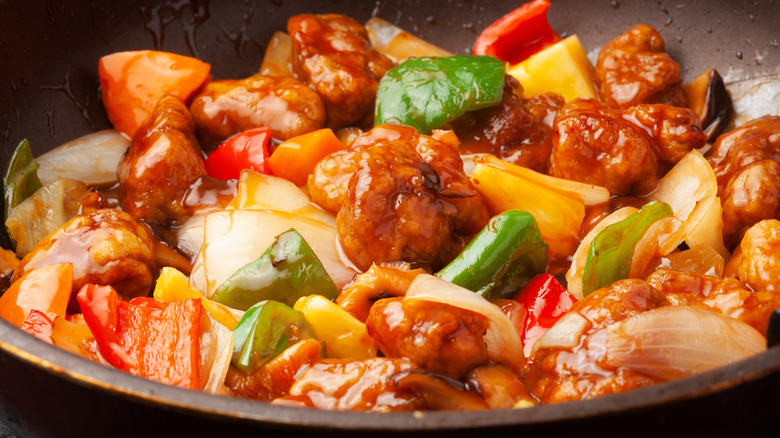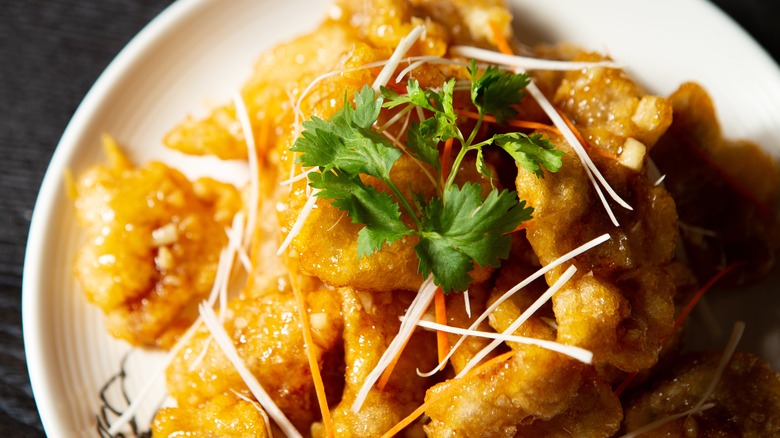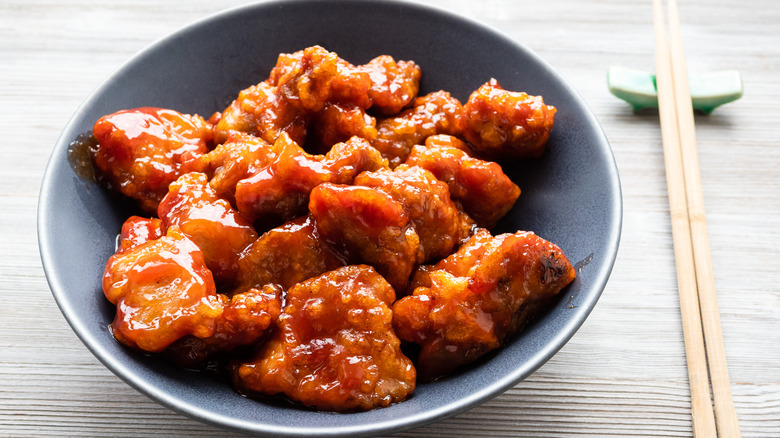Sweet And Sour Pork Is A Totally Different Dish In The US Than It Is In China
American Chinese restaurant menus are rife with evidence of the evolution of traditional Chinese recipes, as they were first cooked to cure homesickness and then to make a living. Much like many of the Italian American recipes we're familiar with today, American Chinese recipes often don't resemble the dishes that influenced them to begin with. Ingredient availability and catering to American tastes meant traditional Chinese dishes became meatier, sweeter, and heavier than their original influences. Sweet and sour pork is definitely one of those dishes.
It's a take-out menu favorite. We're pretty used to the bright orange-red color and thick breading around small chunks of meat, be it pork or chicken. It's usually accompanied by chunks of bell pepper and pineapple and a side of rice. Sweet and sour pork is deep fried and bready, almost drowning in a sweet and tangy sauce, a flavor combination that appeals to people across cultures and income brackets. For many versions, the essential ingredient is ketchup – it gives the color, sweetness, and tanginess associated with the dish.
If you venture to China and find sweet and sour pork on the menu, the experience will be much different from what you order from your local place on a Friday night.
The Chinese version is lighter and more subtle than the American version
Sweet and sour pork, or guō bāo ròu, is one of the dishes served in American Chinese restaurants that doesn't have its roots in Cantonese cooking. Instead, it's from the colder climes of northeastern China, in a city called Harbin in Heilongjiang province. Perhaps made to suit foreigners' tastes, it's an iconic dish of Dongbei (northeast China) cuisine.
The most noticeable difference in a sweet and sour pork dish served in China is the texture and shape of the pork, with fewer clumps of meat and breading and more defined pieces. It's crunchy, sometimes shatteringly crisp when you bite into it because the thin, barely-there sauce coats the pieces of pork without making the potato starch batter soggy. The pork inside is tender despite the crunch of the batter. There's also minimal garnish — no pineapple chunks here. The sauce gets its sweet and sour flavor from sugar and rice vinegar — that's it.
Just like the regionality of pizza in Italy, sweet and sour pork also has regional variations. In Beijing the dish is served in a thinner sauce, while just a few provinces south on the border shared with North Korea, sweet and sour pork is served with a lighter, ketchup-based sauce that still manages to be delicately sweet and sour.
Sweet and sour pork is doable at home
For Chinese cooks, sweet and sour pork is not a dish to attempt at home. It's a treat to have it out on the town at your favorite restaurant — a bit like how a steak from a steakhouse always tastes better than what you make at home. Plus, it's a bit labor intensive; between slicing the meat and assembling the sauce, the dish requires frying the pork twice — once to cook the pork, the other time to crisp up the batter.
If you're brave enough to attempt the dish at home, though, stick with thin slices of pork tenderloin. Logic dictates that deep frying pork loin would dry it out, but by velveting the meat in a marinade your pork will stay tender through two trips into the frying oil. The velveting method turns out tender steak, so it's a perfect method to use here and is used in a lot of Asian cooking. The sauce should be light and delicate and scented with garlic and ginger, but if you prefer a more intense flavor, reduce the sauce more. Whether you use ketchup for the sweet and sour sauce is up to you, but we encourage you to try it without to get the flavors of what's served in China.


